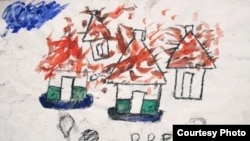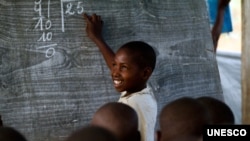The young man said the bombers (Russian-supplied Antonovs) targeted schools and villages indiscriminately. “When they saw buildings, they bombed them,” he told the NGO Save the Children.
His account and others are included in the latest version of the UNESCO publication, Education for All Global Monitoring Report. The yearly publication is part of a global campaign to provide universal primary education within the next three years.
It documents the plight of children from conflict-ridden nations – states that have made the least progress in meeting the Millennium Development Goals. They mandate universal primary education and gender equity in schooling by 2015.
UN statistics show the effects of conflict behind the lagging indicators of educational progress, including hunger, disease and trauma, which impair their ability to learn. Experts say in the long run, a country’s failure to educate its citizens reduces economic growth and increases poverty and underdevelopment.
Pauline Rose, the director of the Education for All Global Monitoring Report, said in 35 conflict-affected countries studied, there are 28 million children out of school – 42 percent of the total. She said the reasons vary.
"It’s insecure to walk to school," she said. For young girls, there’s a fear for their sexual safety, of harassment. In conflict-afflicted countries, rape and sexual violence for young girls are not uncommon."
In some conflicts, all sides adhere to Geneva Conventions prohibiting strikes on public places, including schools and hospitals. But UNESCO says educational infrastructure is a focus of many combatants today.
For example, the UN notes that more than half of Sierra Leone’s primary schools had to be rebuilt after years of war.
In some cases, militants targets schools as symbols of government authority or because they are occupied by troops or security forces, as they are in Yemen and Somalia.
In other instances, schools have been targeted for religious or ideological reasons.
"In Afghanistan," she said, "the idea of girls going to school has been part of the concern of some militant groups [and] is a cause for their direct attacks on girls’ schools. In other parts of the world, schools are caught in the crossfire or militants use them as a base."
Sexual violence and recruitment
Not only does conflict destroy educational facilities, but it also puts both boys and girls at risk of sexual violence. In recent years, the UN has documented evidence of rape against children by armed groups and even the national armies in Chad, Darfur, Sudan and the Democratic Republic of the Congo. Victims often become social outcasts, making it unlikely they’ll keep going to school.
The UN says there’s near impunity for perpetrators. The report says in the DRC, for example, many have been appointed to senior military positions.
School children are also at risk of being recruited as combatants. In some countries, including Sudan, both state and non-state parties have abducted children from refugee camps and displacement centers.
The displaced
Conflict destroys local educational infrastructure and may uproot entire communities, whose residents become internally displaced people (IDPs) or refugees.
According to the UN, there are more than 19 million of them worldwide, and about half are young people under the age of 18.
The UN Refugee Agency says children make up about two-thirds of IDPs in Chad and more than 60% of refugees in Sudan. The UN says countries with large populations recovering from fighting are more likely to have high levels of child labor and lower school attendance because children are kept at home to help their families.
Right to education
Of the displaced, only refugees have the right to education guaranteed under international law. But it’s not always enforced and access to education is uneven. In eastern Chad, there are only two secondary schools for 270,000 refugees from Darfur. Schools in refugee camps often suffer from a lack of full funding for teachers, equipment and textbooks.
Last year, Rose visited the Dadaab camps in northern Kenya, which shelter more than 250,000 refugees from Somalia. Young people make up about a quarter of the camps’ inhabitants.
"You have half the children without access to school, classes of over 300 children," she explained. "You just see the conditions getting worse. These camps have been there for 20 years, so it’s not a short-term situation."
"In Dadaab, one of the things I kept hearing from the young men was that because they did not have access to education [and because] there was no work for them, they had seen many friends return to Somali and take up arms. And also with the idleness of youth, there’s a lot of insecurity within the camps themselves as well."
UNESCO notes that increased funding for education remains a contentious political issue for nearly two dozen conflict states, where military spending exceeds funding for social programs.. Half of those nations are in sub-Saharan Africa.
Defense vs. social service spending
The Education for All Global Monitoring Report says the military budget is twice as large as the primary school budget in Ethiopia. In Chad, it’s four times as large, and in Pakistan, seven times greater.
The study estimates if the conflict states in sub-Saharan Africa could cut military spending by 10%, they could educate more than a quarter of their out-of-school population, or nearly three million children. It says one-fifth of Pakistan’s military budget would provide for universal primary education.
One country has succeeded in increasing funding for education, to great effect. For decades, Botswana has channeled its wealth from diamond exports to fund universal primary education and to create a skills base for its thriving economy.
But experts say so far, Botswana is an exception among countries with lucrative petroleum and mineral resources.
His account and others are included in the latest version of the UNESCO publication, Education for All Global Monitoring Report. The yearly publication is part of a global campaign to provide universal primary education within the next three years.
It documents the plight of children from conflict-ridden nations – states that have made the least progress in meeting the Millennium Development Goals. They mandate universal primary education and gender equity in schooling by 2015.
UN statistics show the effects of conflict behind the lagging indicators of educational progress, including hunger, disease and trauma, which impair their ability to learn. Experts say in the long run, a country’s failure to educate its citizens reduces economic growth and increases poverty and underdevelopment.
Pauline Rose, the director of the Education for All Global Monitoring Report, said in 35 conflict-affected countries studied, there are 28 million children out of school – 42 percent of the total. She said the reasons vary.
"It’s insecure to walk to school," she said. For young girls, there’s a fear for their sexual safety, of harassment. In conflict-afflicted countries, rape and sexual violence for young girls are not uncommon."
In some conflicts, all sides adhere to Geneva Conventions prohibiting strikes on public places, including schools and hospitals. But UNESCO says educational infrastructure is a focus of many combatants today.
For example, the UN notes that more than half of Sierra Leone’s primary schools had to be rebuilt after years of war.
In some cases, militants targets schools as symbols of government authority or because they are occupied by troops or security forces, as they are in Yemen and Somalia.
In other instances, schools have been targeted for religious or ideological reasons.
"In Afghanistan," she said, "the idea of girls going to school has been part of the concern of some militant groups [and] is a cause for their direct attacks on girls’ schools. In other parts of the world, schools are caught in the crossfire or militants use them as a base."
Sexual violence and recruitment
Not only does conflict destroy educational facilities, but it also puts both boys and girls at risk of sexual violence. In recent years, the UN has documented evidence of rape against children by armed groups and even the national armies in Chad, Darfur, Sudan and the Democratic Republic of the Congo. Victims often become social outcasts, making it unlikely they’ll keep going to school.
The UN says there’s near impunity for perpetrators. The report says in the DRC, for example, many have been appointed to senior military positions.
School children are also at risk of being recruited as combatants. In some countries, including Sudan, both state and non-state parties have abducted children from refugee camps and displacement centers.
The displaced
Conflict destroys local educational infrastructure and may uproot entire communities, whose residents become internally displaced people (IDPs) or refugees.
According to the UN, there are more than 19 million of them worldwide, and about half are young people under the age of 18.
The UN Refugee Agency says children make up about two-thirds of IDPs in Chad and more than 60% of refugees in Sudan. The UN says countries with large populations recovering from fighting are more likely to have high levels of child labor and lower school attendance because children are kept at home to help their families.
Right to education
Of the displaced, only refugees have the right to education guaranteed under international law. But it’s not always enforced and access to education is uneven. In eastern Chad, there are only two secondary schools for 270,000 refugees from Darfur. Schools in refugee camps often suffer from a lack of full funding for teachers, equipment and textbooks.
Last year, Rose visited the Dadaab camps in northern Kenya, which shelter more than 250,000 refugees from Somalia. Young people make up about a quarter of the camps’ inhabitants.
"You have half the children without access to school, classes of over 300 children," she explained. "You just see the conditions getting worse. These camps have been there for 20 years, so it’s not a short-term situation."
"In Dadaab, one of the things I kept hearing from the young men was that because they did not have access to education [and because] there was no work for them, they had seen many friends return to Somali and take up arms. And also with the idleness of youth, there’s a lot of insecurity within the camps themselves as well."
UNESCO notes that increased funding for education remains a contentious political issue for nearly two dozen conflict states, where military spending exceeds funding for social programs.. Half of those nations are in sub-Saharan Africa.
Defense vs. social service spending
The Education for All Global Monitoring Report says the military budget is twice as large as the primary school budget in Ethiopia. In Chad, it’s four times as large, and in Pakistan, seven times greater.
The study estimates if the conflict states in sub-Saharan Africa could cut military spending by 10%, they could educate more than a quarter of their out-of-school population, or nearly three million children. It says one-fifth of Pakistan’s military budget would provide for universal primary education.
One country has succeeded in increasing funding for education, to great effect. For decades, Botswana has channeled its wealth from diamond exports to fund universal primary education and to create a skills base for its thriving economy.
But experts say so far, Botswana is an exception among countries with lucrative petroleum and mineral resources.












